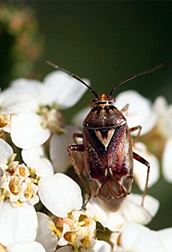Deciding When To Spray: Sometimes It Is More Than Just Numbers
BELTSVILLE, MD.
Research by U.S. Department of Agriculture (USDA) scientists focused on a major threat to cotton in the Southwestern United States could soon help growers cut back on insecticide use.
Growers in the Southwest often spray insecticides to control western tarnished plant bugs (Lygus hesperus). But before they do, they will walk through their fields waving hand-held nets and count the number of L. hesperus they capture. They decide to spray based on capture thresholds that vary from one region to the next.
Studies by USDA Agricultural Research Service (ARS) scientists Dale Spurgeon and W. Rodney Cooper show that these “sweepnet” survey results can be misinterpreted, and that important factors in determining when to spray-such as the age of the insects and the growth stage of the cotton-are often overlooked.

ARS researchers are refining the way cotton farmers spray pesticides to control the western tarnished plant bug (Lygus Hesperus).
Photo courtesy of Whitney Cranshaw, Colorado State University, Bugwood.org.
Spurgeon is based at the U.S. Arid-Land Agricultural Research Center in Maricopa, Ariz. and Cooper is with the Yakima Agricultural Research Laboratory in Wapato, Wash. They conducted the research at a former ARS research site in Shafter, Calif. ARS is USDA’s principal intramural scientific research agency.
In one study, the researchers videotaped L. hesperus feeding on cotton in a laboratory and released others to feed on cotton plants in a greenhouse to assess the feeding habits and damage levels caused by two types of nymphs (3rd and 5th instars) and pre-reproductive adults. Results, published in Environmental Entomology (October 2013), showed that the older 5th instar nymphs caused significantly more damage than the younger nymphs and older adults. The results show the importance of determining the life stages of the lygus infesting the cotton, not just the total numbers.
In another study, they marked adult L. hesperus and periodically released them into rows of upland and pima cotton over two growing seasons. They collected as many of the marked insects as possible the day after each release, along with any wild L. hesperus attracted to the cotton. Releasing and re-collecting marked insects allowed them to check on the effectiveness of the collection efforts, which followed standard sweepnet protocols. Insects caught in the nets were dissected to determine their ages.
Results, published in the Journal of Entomological Science (July 2013), showed that in both species of cotton, captured populations were dominated by mature adults that cause less damage. As cotton plants grew, collection efforts also became less efficient because larger and leafier plants offered the insects more foliage for “hiding out.”
The research also showed that in pima cotton, the more damage-inducing younger adults preferred to feed on the ends of the plant branches, which are substantially shielded by foliage. That makes them harder to capture and more likely to be undercounted than older adults. This wasn’t an issue in upland cotton because it has a more open architecture.
Taken together, the results suggest that L. hesperus sampling methods should be re-evaluated and that growers may need to adopt different methods for different types of cotton.∆